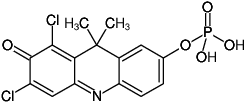9H-(1,3-Dichloro-9,9-dimethylacridin-2-one-7-yl) phosphate, Bis(triethylammonium) salt
| Cat. No. | Amount | Price (EUR) | Buy / Note |
|---|---|---|---|
| APC-001-1 | 1 mg | 83,20 | Add to Basket/Quote Add to Notepad |
| APC-001-5 | 5 x 1 mg | 292,70 | Add to Basket/Quote Add to Notepad |

For general laboratory use.
Shipping: shipped at ambient temperature
Storage Conditions: store at -20 °C
store dark
Shelf Life: 12 months after date of delivery
Molecular Formula: C15H12Cl2NO5P (free acid)
Molecular Weight: 388.14 g/mol (free acid)
Exact Mass: 386.98 g/mol (free acid)
CAS#: 500883-59-0
Purity: > 95 % (HPLC)
Form: solid
Spectroscopic Properties: λexc 477 nm, λem 628 nm, ε 26.0 L mmol-1 cm-1 (50 mM Potassium Phosphate pH 7.0)
Description:
DDAO-phosphate is a long-wavelength, phosphatase substrate for both solution-based assays[1,2] and the amplified detection of specific targets on blots[3,4]. Hydrolysis of the phosphate bond yields a brightly red-fluorescent product with absorption/emission maxima of ~646/659 nm that is efficiently excited by the 633 nm spectral line of the He–Ne laser. The shift of emission maxima between DDAO-phosphate and the dephosphorylated product is larger than 200 nm and permits both species to be easily distinguished. DDAO phosphate has good water solubility, a low KM and a high turnover rate.
BIOZ Product Citations:
Selected References:
[1] Leira et al. (2000) Characterization of 9H-(1,3-dichloro-9,9-dimethylacridin-2-one-7-yl)-phosphate (DDAO) as substrate of PP-2A in a fluorimetric micro-plate assay for diarrhetic shellfish toxins (DSP). Toxicon 38:1833.
[2] Stratis-Cullum et al. (2003) A miniature biochip system for detection of aerosolized Bacillus globigii spores. Anal. Chem. 75:275.
[3] Pretty et al. (2001) Green/red dual fluorescence detection of total protein and alkaline phosphate-conjugated probes on blotting membranes. Electrophoresis 22:896.
[4] Kurien et al. (2015) Other notable methods of membrane protein detection: A brief review. Detection of Blotted Proteins, Springer Chapter 36:357.